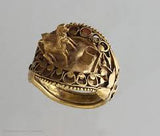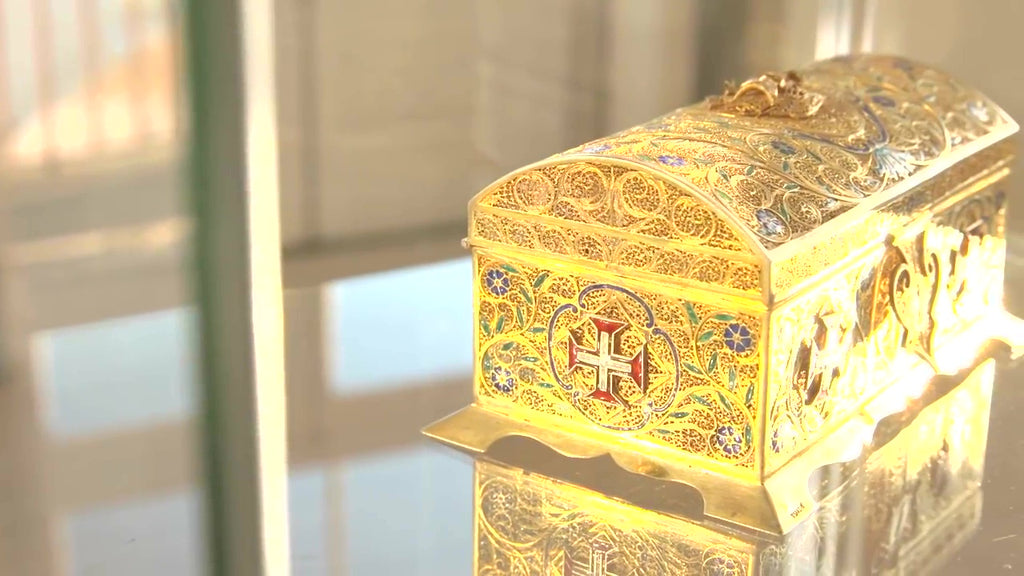The oldest known filigree jewellery is more than 7,000 years old and was discovered in Egypt. Today, there are only a few goldsmiths able to making filigree jewellery and most of them are Portuguese.
This is an opportunity to discover what lies behind these fantastic jewels that are now worn by the greatest stars.
The filigree technique in jewellery
The filigree technique is one of the oldest and most beautiful techniques used in jewellery. It consists of twisting and plaiting fine precious metal threads (up to 0.2mm in diameter) to get beautiful pieces of jewelry similar to lace-like patterns.
Two different filigree techniques
There are two types of filigrees: the application filigree which consists of applying very fine silver or gold threads to solid silverware pieces to obtain decorative effects.
The integration filigree technique, much more difficult to master, consists in creating a jewel made entirely in filigree.
The filigree applies only to gold and silver
The filigree technique uses only precious and pure metals, gold and silver in particular. These metals are the only ones that produce very fine threads because of their low melting temperature and elasticity when heated. One gram of gold or silver makes it possible to obtain several meter of thread;
The metal wires are twisted, beaten, softened and refined with a heat source then cleaned before being crafted by goldsmiths.


The filigree technique is very delicate and requires a very particular skill, dexterity and experience. Today, it is only mastered by a few craftsmen located in Russia, India and Portugal.






7000 years ago the first filigree jewellery appeared
The filigree art is probably one of the oldest jewellery techniques. Filigree jewellery is found in the Egyptian, Etruscan and Greek civilizations as well as in the Roman and Arab civilizations.

The most basic filigree techniques were already used in Egypt at the end of the 5th millennium. At Armana were discovered rings wrapped with threads, which can be considered a primitive form of filigree. Filigrees were also discovered on rings from the same period.
These small copper or silver beaded threads twist together to close the ring. However, it seems that the filigree was then used more to reinforce the fasteners of the jewellery and not for their decoration. Illustration: Ashburnham Ring - Tomb of Thutmose III - Bristish Museum
 Later, about 2500 years ago, between the 4th and 3rd centuries BC, it was the Sumerians who largely perfected the techniques of the filigree. It was at this time that the appeal of gold developed.
Later, about 2500 years ago, between the 4th and 3rd centuries BC, it was the Sumerians who largely perfected the techniques of the filigree. It was at this time that the appeal of gold developed.
The filigree technique is then observed on many objects. The excavations of the royal tombs of Ur have revealed many filigree jewellery but also helmets, daggers or statuettes.
500 years ago, Portuguese goldsmiths became the masters of watermarking
In 1500, Pedro Alvares Cabral took possession of Brazil on behalf of the Portuguese. Gold then arrived in Portugal in large quantities and allowed João V to display splendour comparable to that of Louis XIV.
This profusion of gold and precious stones attracts the great master jewellers who are revolutionizing jewellery-making techniques by positioning Portugal among the best jewellery manufacturers in Europe.
The filigree technique was then used to design cult objects and magnificent decorative objects. Illustrations: 17th-century object made of gold filigree - Gondomar Museum (Portugal)




Today, Portugal is one of the last countries to master the art of Filigree.

Nowadays, Portugal remains one of the last countries in which the filigree technique is still mastered. This has been made possible by a long tradition maintained from generation to generation, but also, one must say, by the low labour costs in Portugal, which make it possible to maintain time-consuming jewellery techniques.
Surprisingly modern filigree jewellery
 Today, the whole world is rediscovering this technique of goldsmithing more than 7000 years old and is surprised by the modernity of this kind of jewellery. One of the most beautiful uses of this technique can be found on the Heart of Viana (Coração de Viana) made for hundreds of years in Northern Portugal, carried by generations of young Portuguese girls and nowadays displayed around the neck of the greatest stars such as Sharon Stone. The filigree technique makes it possible to create an incredible variety of jewellery by unleashing all the creativity of the craftsmen. Rings, bracelets, earrings, and pendants are nowadays freely inspired by the vegetable or animal world or by esoteric or religious symbols.
Today, the whole world is rediscovering this technique of goldsmithing more than 7000 years old and is surprised by the modernity of this kind of jewellery. One of the most beautiful uses of this technique can be found on the Heart of Viana (Coração de Viana) made for hundreds of years in Northern Portugal, carried by generations of young Portuguese girls and nowadays displayed around the neck of the greatest stars such as Sharon Stone. The filigree technique makes it possible to create an incredible variety of jewellery by unleashing all the creativity of the craftsmen. Rings, bracelets, earrings, and pendants are nowadays freely inspired by the vegetable or animal world or by esoteric or religious symbols.
You want to know more about our Collection of filigree jewellery from Portugal? Do not hesitate, we uphold Portuguese craftsmen and heritage and we guarantee that all our filigree jewellery is 100% made in Portugal.

We offer a selected collection of jewellery from the Portuguese heritage: Heart of Viana pendants, Da Rainha earrings or Rendas rings for example. You will also find a collection of more recent creations but still using the ancestral techniques of filigree: Borboleta necklace in silver, Infinito necklace in silver... and many others!

